Strategic Management Report: Process, Strategies, and Global Markets
VerifiedAdded on 2020/04/15
|10
|2395
|63
Report
AI Summary
This report provides a comprehensive overview of strategic management, delving into the strategic management process, generic strategies (cost leadership, differentiation, and focus), and the significance of organizational vision, mission, and goals. It explores how the value chain is utilized to maximize organizational performance, emphasizing the importance of environmental scanning, strategy formulation, implementation, and evaluation. The report examines related and unrelated diversification strategies and their impact on business expansion. Furthermore, it discusses the advantages and disadvantages of competing in international markets, including access to new customers, cost reduction, diversification of business risks, and the associated political, economic, and cultural risks. The analysis highlights the importance of strategic management for achieving long-term success and growth in a competitive global environment.
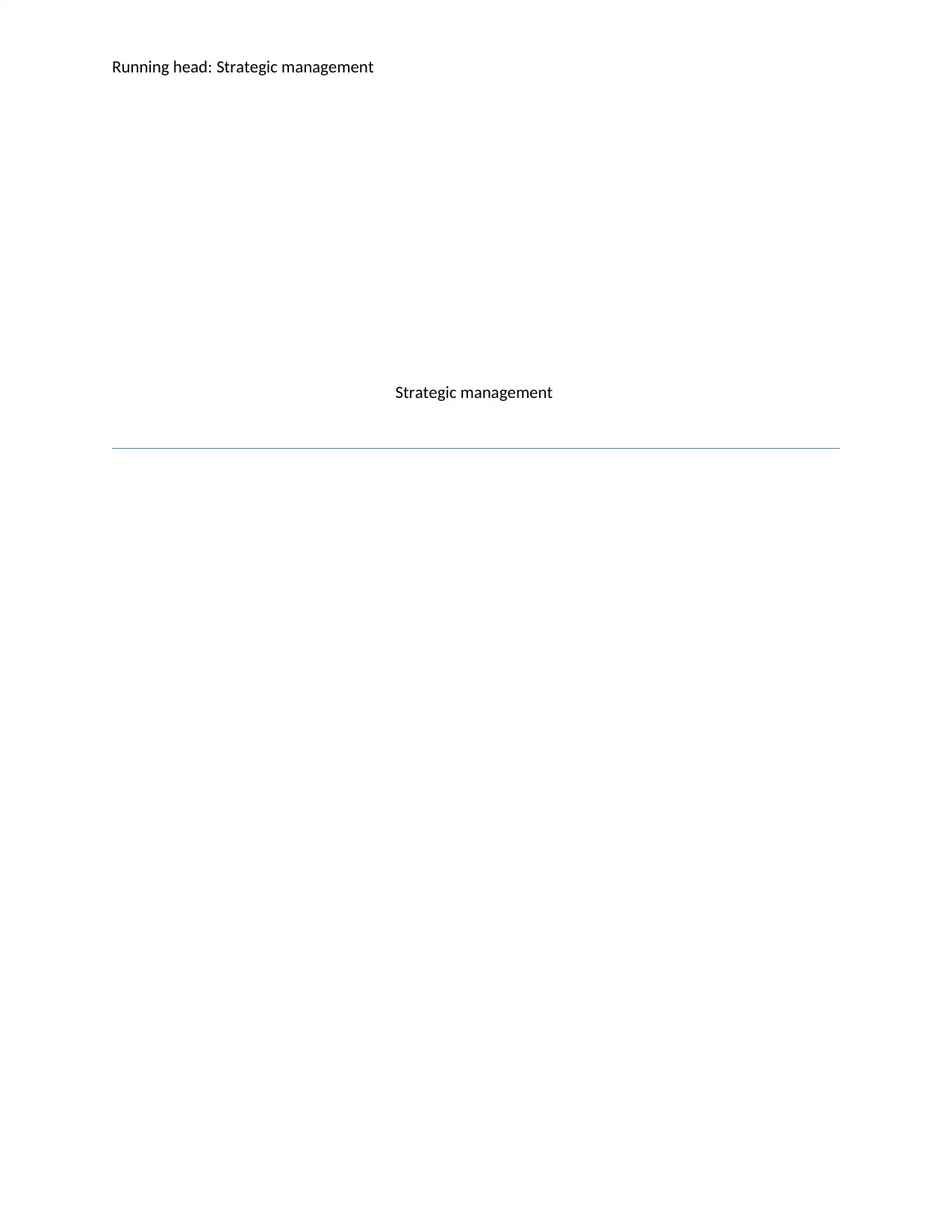
Running head: Strategic management
Strategic management
Strategic management
Paraphrase This Document
Need a fresh take? Get an instant paraphrase of this document with our AI Paraphraser
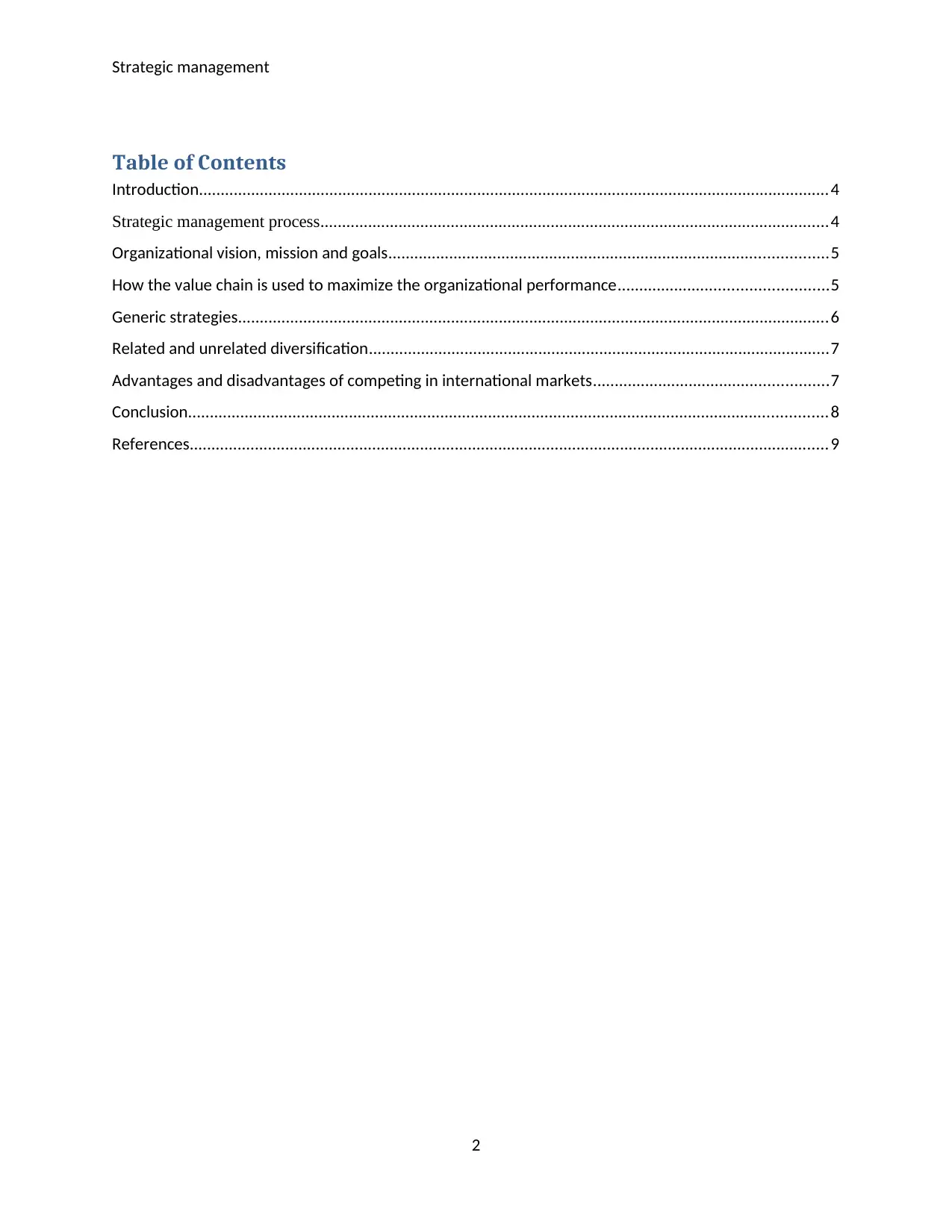
Strategic management
Table of Contents
Introduction.................................................................................................................................................4
Strategic management process.....................................................................................................................4
Organizational vision, mission and goals.....................................................................................................5
How the value chain is used to maximize the organizational performance................................................5
Generic strategies........................................................................................................................................6
Related and unrelated diversification..........................................................................................................7
Advantages and disadvantages of competing in international markets......................................................7
Conclusion...................................................................................................................................................8
References...................................................................................................................................................9
2
Table of Contents
Introduction.................................................................................................................................................4
Strategic management process.....................................................................................................................4
Organizational vision, mission and goals.....................................................................................................5
How the value chain is used to maximize the organizational performance................................................5
Generic strategies........................................................................................................................................6
Related and unrelated diversification..........................................................................................................7
Advantages and disadvantages of competing in international markets......................................................7
Conclusion...................................................................................................................................................8
References...................................................................................................................................................9
2
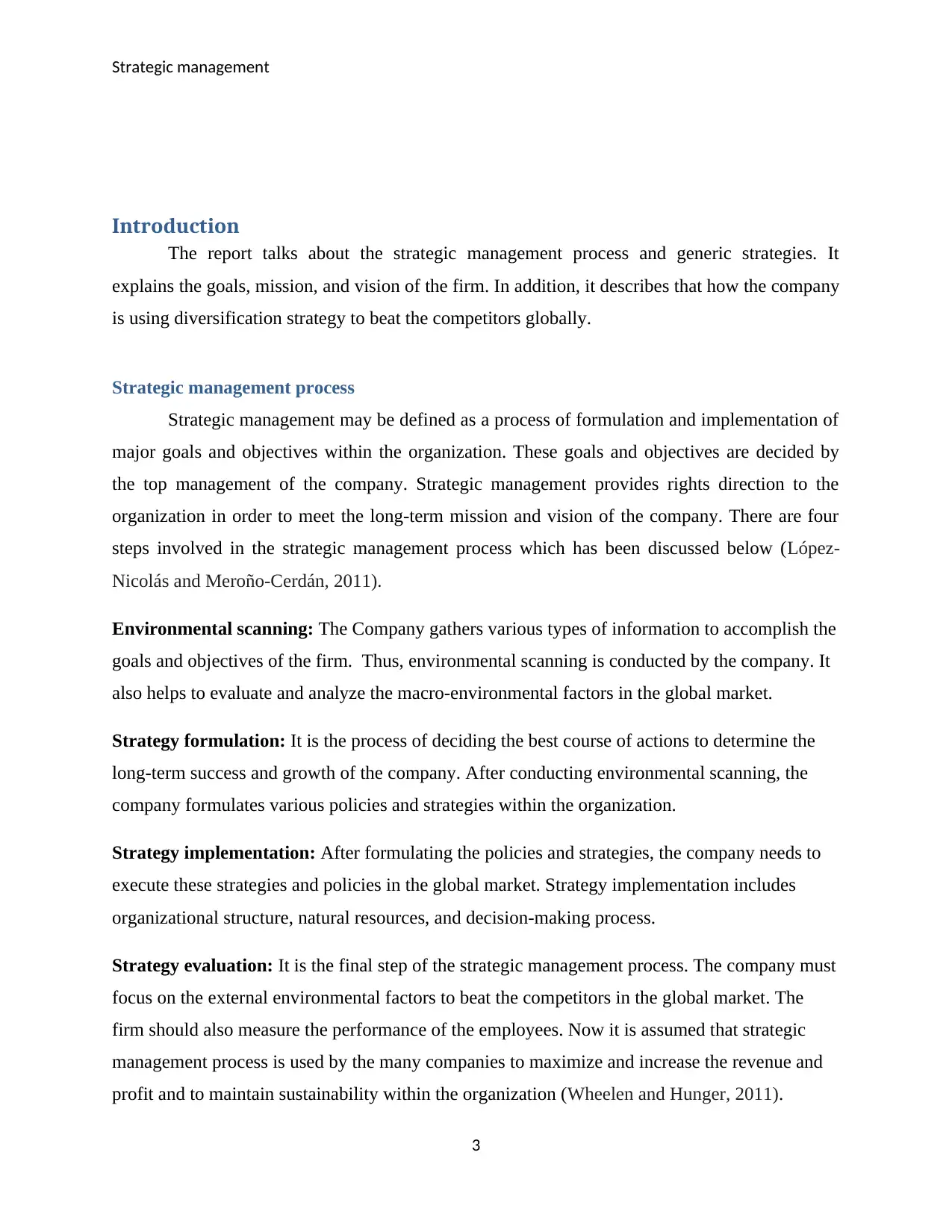
Strategic management
Introduction
The report talks about the strategic management process and generic strategies. It
explains the goals, mission, and vision of the firm. In addition, it describes that how the company
is using diversification strategy to beat the competitors globally.
Strategic management process
Strategic management may be defined as a process of formulation and implementation of
major goals and objectives within the organization. These goals and objectives are decided by
the top management of the company. Strategic management provides rights direction to the
organization in order to meet the long-term mission and vision of the company. There are four
steps involved in the strategic management process which has been discussed below (López-
Nicolás and Meroño-Cerdán, 2011).
Environmental scanning: The Company gathers various types of information to accomplish the
goals and objectives of the firm. Thus, environmental scanning is conducted by the company. It
also helps to evaluate and analyze the macro-environmental factors in the global market.
Strategy formulation: It is the process of deciding the best course of actions to determine the
long-term success and growth of the company. After conducting environmental scanning, the
company formulates various policies and strategies within the organization.
Strategy implementation: After formulating the policies and strategies, the company needs to
execute these strategies and policies in the global market. Strategy implementation includes
organizational structure, natural resources, and decision-making process.
Strategy evaluation: It is the final step of the strategic management process. The company must
focus on the external environmental factors to beat the competitors in the global market. The
firm should also measure the performance of the employees. Now it is assumed that strategic
management process is used by the many companies to maximize and increase the revenue and
profit and to maintain sustainability within the organization (Wheelen and Hunger, 2011).
3
Introduction
The report talks about the strategic management process and generic strategies. It
explains the goals, mission, and vision of the firm. In addition, it describes that how the company
is using diversification strategy to beat the competitors globally.
Strategic management process
Strategic management may be defined as a process of formulation and implementation of
major goals and objectives within the organization. These goals and objectives are decided by
the top management of the company. Strategic management provides rights direction to the
organization in order to meet the long-term mission and vision of the company. There are four
steps involved in the strategic management process which has been discussed below (López-
Nicolás and Meroño-Cerdán, 2011).
Environmental scanning: The Company gathers various types of information to accomplish the
goals and objectives of the firm. Thus, environmental scanning is conducted by the company. It
also helps to evaluate and analyze the macro-environmental factors in the global market.
Strategy formulation: It is the process of deciding the best course of actions to determine the
long-term success and growth of the company. After conducting environmental scanning, the
company formulates various policies and strategies within the organization.
Strategy implementation: After formulating the policies and strategies, the company needs to
execute these strategies and policies in the global market. Strategy implementation includes
organizational structure, natural resources, and decision-making process.
Strategy evaluation: It is the final step of the strategic management process. The company must
focus on the external environmental factors to beat the competitors in the global market. The
firm should also measure the performance of the employees. Now it is assumed that strategic
management process is used by the many companies to maximize and increase the revenue and
profit and to maintain sustainability within the organization (Wheelen and Hunger, 2011).
3
⊘ This is a preview!⊘
Do you want full access?
Subscribe today to unlock all pages.

Trusted by 1+ million students worldwide
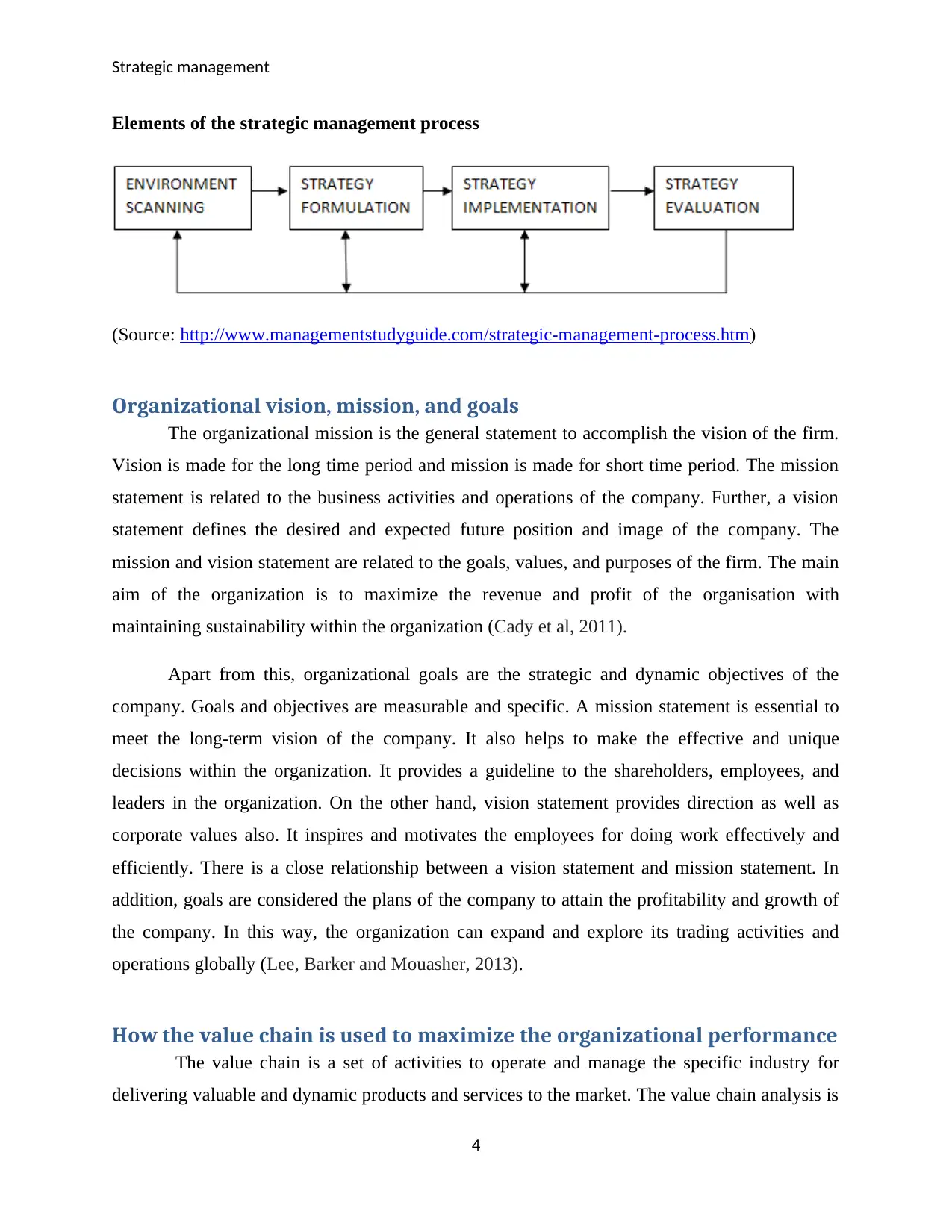
Strategic management
Elements of the strategic management process
(Source: http://www.managementstudyguide.com/strategic-management-process.htm)
Organizational vision, mission, and goals
The organizational mission is the general statement to accomplish the vision of the firm.
Vision is made for the long time period and mission is made for short time period. The mission
statement is related to the business activities and operations of the company. Further, a vision
statement defines the desired and expected future position and image of the company. The
mission and vision statement are related to the goals, values, and purposes of the firm. The main
aim of the organization is to maximize the revenue and profit of the organisation with
maintaining sustainability within the organization (Cady et al, 2011).
Apart from this, organizational goals are the strategic and dynamic objectives of the
company. Goals and objectives are measurable and specific. A mission statement is essential to
meet the long-term vision of the company. It also helps to make the effective and unique
decisions within the organization. It provides a guideline to the shareholders, employees, and
leaders in the organization. On the other hand, vision statement provides direction as well as
corporate values also. It inspires and motivates the employees for doing work effectively and
efficiently. There is a close relationship between a vision statement and mission statement. In
addition, goals are considered the plans of the company to attain the profitability and growth of
the company. In this way, the organization can expand and explore its trading activities and
operations globally (Lee, Barker and Mouasher, 2013).
How the value chain is used to maximize the organizational performance
The value chain is a set of activities to operate and manage the specific industry for
delivering valuable and dynamic products and services to the market. The value chain analysis is
4
Elements of the strategic management process
(Source: http://www.managementstudyguide.com/strategic-management-process.htm)
Organizational vision, mission, and goals
The organizational mission is the general statement to accomplish the vision of the firm.
Vision is made for the long time period and mission is made for short time period. The mission
statement is related to the business activities and operations of the company. Further, a vision
statement defines the desired and expected future position and image of the company. The
mission and vision statement are related to the goals, values, and purposes of the firm. The main
aim of the organization is to maximize the revenue and profit of the organisation with
maintaining sustainability within the organization (Cady et al, 2011).
Apart from this, organizational goals are the strategic and dynamic objectives of the
company. Goals and objectives are measurable and specific. A mission statement is essential to
meet the long-term vision of the company. It also helps to make the effective and unique
decisions within the organization. It provides a guideline to the shareholders, employees, and
leaders in the organization. On the other hand, vision statement provides direction as well as
corporate values also. It inspires and motivates the employees for doing work effectively and
efficiently. There is a close relationship between a vision statement and mission statement. In
addition, goals are considered the plans of the company to attain the profitability and growth of
the company. In this way, the organization can expand and explore its trading activities and
operations globally (Lee, Barker and Mouasher, 2013).
How the value chain is used to maximize the organizational performance
The value chain is a set of activities to operate and manage the specific industry for
delivering valuable and dynamic products and services to the market. The value chain analysis is
4
Paraphrase This Document
Need a fresh take? Get an instant paraphrase of this document with our AI Paraphraser

Strategic management
a technique and tool which is used by the company to analyze and evaluate the internal activities
of the firm. It also provides various competitive advantages in the global market. The value chain
analysis includes operations, outbound logistics, inbound logistics, services, marketing, and
sales. The value chain analysis is the flexible strategy to improve and enhance the efficiency and
performance of the employees. It also helps to understand and evaluate the issues and key
challenges of the organization. Along with this, it helps to reduce the cost of the company. Apart
from this, value chain helps to provide satisfaction to the customers across the world. Through
value chain analysis, the company is able to evaluate and identify the strengths and weaknesses
of the organization (Merschmann and Thonemann, 2011).
The company is using value chain analysis to build and develop an effective and dynamic
relationship with customers across the world. Along with this, it reduces the delivery times of the
company and maintains an optimum level of inventory within the organization, Further, it
enhances and increases the revenue and profit of the firm. In addition, value chain analysis is
used by the company to improve and enhance the performance of the organization as well as
employees. It is the effective tool to attain the long-term success and growth within the
organization (Seuring and Gold, 2012).
Generic strategies
Generic strategies are developed by the Michel porter to gain the competitive benefits in
the global market. These strategies are essential in order to attain the mission and vision of the
firm. There are three types of generic strategies which include cost leadership, differentiation,
and focus strategy. The generic strategies have been discussed below (Tanwar, 2013).
Cost leadership strategy: This strategy is used by the company to gain the competitive benefits
in the global market. This strategy is related to the cost of the company. The company evaluates
and analyzes the lower cost of the production to gain the long-term growth and success within
the organization.
Differentiation strategy: The firm uses differentiation strategy to differentiate the products,
goods and services from the competitors across the world. The company selects most appropriate
and effective strategy to differentiate the products from the competitors in the global market. The
5
a technique and tool which is used by the company to analyze and evaluate the internal activities
of the firm. It also provides various competitive advantages in the global market. The value chain
analysis includes operations, outbound logistics, inbound logistics, services, marketing, and
sales. The value chain analysis is the flexible strategy to improve and enhance the efficiency and
performance of the employees. It also helps to understand and evaluate the issues and key
challenges of the organization. Along with this, it helps to reduce the cost of the company. Apart
from this, value chain helps to provide satisfaction to the customers across the world. Through
value chain analysis, the company is able to evaluate and identify the strengths and weaknesses
of the organization (Merschmann and Thonemann, 2011).
The company is using value chain analysis to build and develop an effective and dynamic
relationship with customers across the world. Along with this, it reduces the delivery times of the
company and maintains an optimum level of inventory within the organization, Further, it
enhances and increases the revenue and profit of the firm. In addition, value chain analysis is
used by the company to improve and enhance the performance of the organization as well as
employees. It is the effective tool to attain the long-term success and growth within the
organization (Seuring and Gold, 2012).
Generic strategies
Generic strategies are developed by the Michel porter to gain the competitive benefits in
the global market. These strategies are essential in order to attain the mission and vision of the
firm. There are three types of generic strategies which include cost leadership, differentiation,
and focus strategy. The generic strategies have been discussed below (Tanwar, 2013).
Cost leadership strategy: This strategy is used by the company to gain the competitive benefits
in the global market. This strategy is related to the cost of the company. The company evaluates
and analyzes the lower cost of the production to gain the long-term growth and success within
the organization.
Differentiation strategy: The firm uses differentiation strategy to differentiate the products,
goods and services from the competitors across the world. The company selects most appropriate
and effective strategy to differentiate the products from the competitors in the global market. The
5
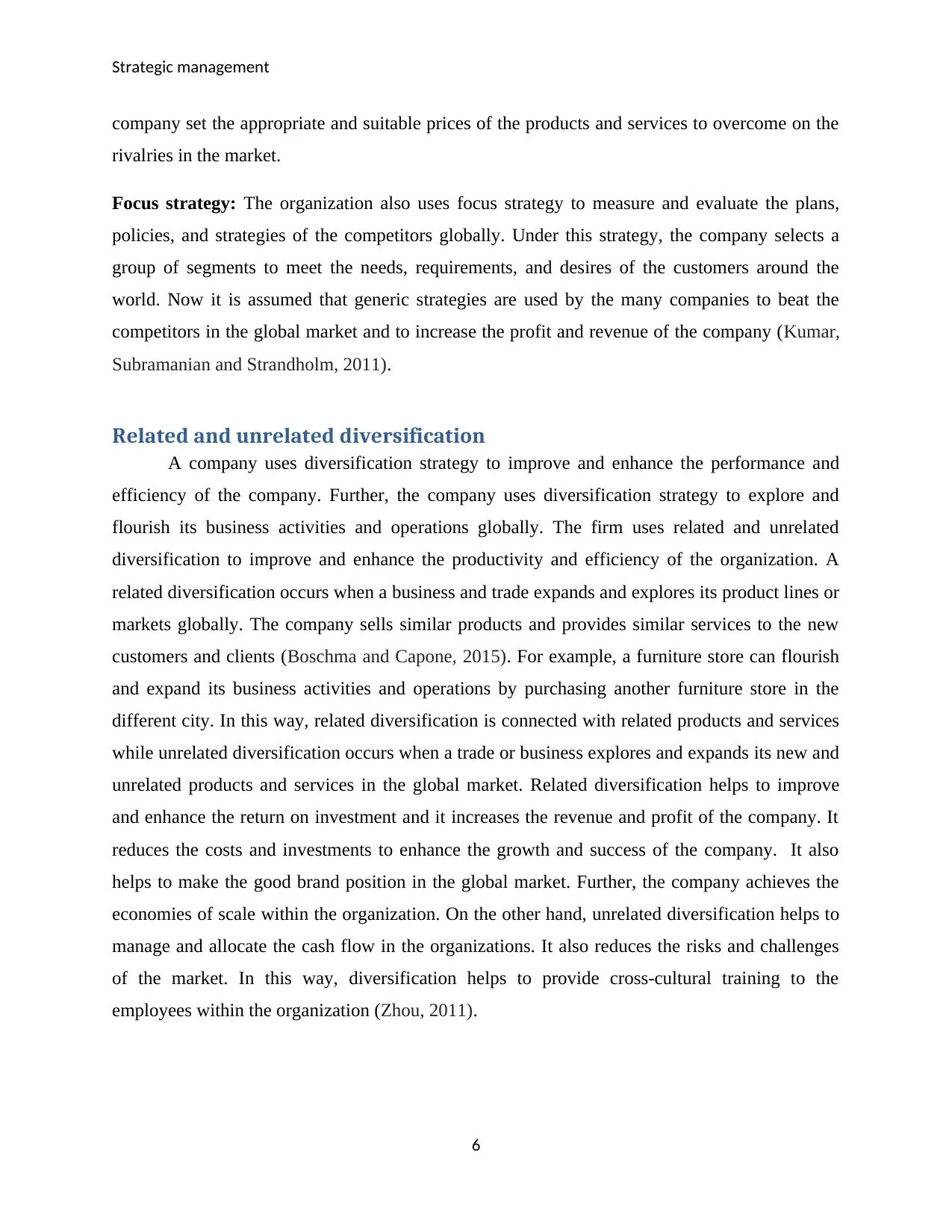
Strategic management
company set the appropriate and suitable prices of the products and services to overcome on the
rivalries in the market.
Focus strategy: The organization also uses focus strategy to measure and evaluate the plans,
policies, and strategies of the competitors globally. Under this strategy, the company selects a
group of segments to meet the needs, requirements, and desires of the customers around the
world. Now it is assumed that generic strategies are used by the many companies to beat the
competitors in the global market and to increase the profit and revenue of the company (Kumar,
Subramanian and Strandholm, 2011).
Related and unrelated diversification
A company uses diversification strategy to improve and enhance the performance and
efficiency of the company. Further, the company uses diversification strategy to explore and
flourish its business activities and operations globally. The firm uses related and unrelated
diversification to improve and enhance the productivity and efficiency of the organization. A
related diversification occurs when a business and trade expands and explores its product lines or
markets globally. The company sells similar products and provides similar services to the new
customers and clients (Boschma and Capone, 2015). For example, a furniture store can flourish
and expand its business activities and operations by purchasing another furniture store in the
different city. In this way, related diversification is connected with related products and services
while unrelated diversification occurs when a trade or business explores and expands its new and
unrelated products and services in the global market. Related diversification helps to improve
and enhance the return on investment and it increases the revenue and profit of the company. It
reduces the costs and investments to enhance the growth and success of the company. It also
helps to make the good brand position in the global market. Further, the company achieves the
economies of scale within the organization. On the other hand, unrelated diversification helps to
manage and allocate the cash flow in the organizations. It also reduces the risks and challenges
of the market. In this way, diversification helps to provide cross-cultural training to the
employees within the organization (Zhou, 2011).
6
company set the appropriate and suitable prices of the products and services to overcome on the
rivalries in the market.
Focus strategy: The organization also uses focus strategy to measure and evaluate the plans,
policies, and strategies of the competitors globally. Under this strategy, the company selects a
group of segments to meet the needs, requirements, and desires of the customers around the
world. Now it is assumed that generic strategies are used by the many companies to beat the
competitors in the global market and to increase the profit and revenue of the company (Kumar,
Subramanian and Strandholm, 2011).
Related and unrelated diversification
A company uses diversification strategy to improve and enhance the performance and
efficiency of the company. Further, the company uses diversification strategy to explore and
flourish its business activities and operations globally. The firm uses related and unrelated
diversification to improve and enhance the productivity and efficiency of the organization. A
related diversification occurs when a business and trade expands and explores its product lines or
markets globally. The company sells similar products and provides similar services to the new
customers and clients (Boschma and Capone, 2015). For example, a furniture store can flourish
and expand its business activities and operations by purchasing another furniture store in the
different city. In this way, related diversification is connected with related products and services
while unrelated diversification occurs when a trade or business explores and expands its new and
unrelated products and services in the global market. Related diversification helps to improve
and enhance the return on investment and it increases the revenue and profit of the company. It
reduces the costs and investments to enhance the growth and success of the company. It also
helps to make the good brand position in the global market. Further, the company achieves the
economies of scale within the organization. On the other hand, unrelated diversification helps to
manage and allocate the cash flow in the organizations. It also reduces the risks and challenges
of the market. In this way, diversification helps to provide cross-cultural training to the
employees within the organization (Zhou, 2011).
6
⊘ This is a preview!⊘
Do you want full access?
Subscribe today to unlock all pages.

Trusted by 1+ million students worldwide

Strategic management
Advantages and disadvantages of competing in international markets
There are various benefits of the competing in the international markets which have been
discussed below (Blocker et al, 2011).
Access to new customers: If the company competes and participates in the international market
then it provides various benefits to the customers in the market. It helps to maintain effective and
unique contacts with customers in the global market (Nielsen and Nielsen, 2011).
Lowering cost: It is another important benefit of the international market. It helps to reduce the
cost of the company. Further, it increases the sales volume of the organization by entering into
the international market. It also provides competitive advantages in the global market.
Diversification of the business risk: It also helps to the diversification of the operation and
business risks and challenges in the market. In this way, the company is able to beat the
competitors across the world. Now it is assumed that international market provides various
benefits to the organization.
There are some disadvantages of the competing in the international market which have been
discussed below.
Political risk: The political risk affects the business activities and operations of the firm.
Therefore, the company needs to focus on the political risk to gain the long-term success and
growth in the market.
Economic risk: This type of risk is related to the economic conditions, currency exchange rates
and policies of the country. It is the biggest disadvantage of the international market.
Cultural risk: The cultural risk also exists in the global market. Therefore, the company needs
to control and overcome on this risk in order to attain the long-term goals and objectives of the
firm (Michaelidou, Siamagka, and Christodoulides, 2011.)
Conclusion
On the above discussion, it has been evaluated that strategic management process plays a
significant role in each and every company. Further, generic strategies and value chain analysis
7
Advantages and disadvantages of competing in international markets
There are various benefits of the competing in the international markets which have been
discussed below (Blocker et al, 2011).
Access to new customers: If the company competes and participates in the international market
then it provides various benefits to the customers in the market. It helps to maintain effective and
unique contacts with customers in the global market (Nielsen and Nielsen, 2011).
Lowering cost: It is another important benefit of the international market. It helps to reduce the
cost of the company. Further, it increases the sales volume of the organization by entering into
the international market. It also provides competitive advantages in the global market.
Diversification of the business risk: It also helps to the diversification of the operation and
business risks and challenges in the market. In this way, the company is able to beat the
competitors across the world. Now it is assumed that international market provides various
benefits to the organization.
There are some disadvantages of the competing in the international market which have been
discussed below.
Political risk: The political risk affects the business activities and operations of the firm.
Therefore, the company needs to focus on the political risk to gain the long-term success and
growth in the market.
Economic risk: This type of risk is related to the economic conditions, currency exchange rates
and policies of the country. It is the biggest disadvantage of the international market.
Cultural risk: The cultural risk also exists in the global market. Therefore, the company needs
to control and overcome on this risk in order to attain the long-term goals and objectives of the
firm (Michaelidou, Siamagka, and Christodoulides, 2011.)
Conclusion
On the above discussion, it has been evaluated that strategic management process plays a
significant role in each and every company. Further, generic strategies and value chain analysis
7
Paraphrase This Document
Need a fresh take? Get an instant paraphrase of this document with our AI Paraphraser
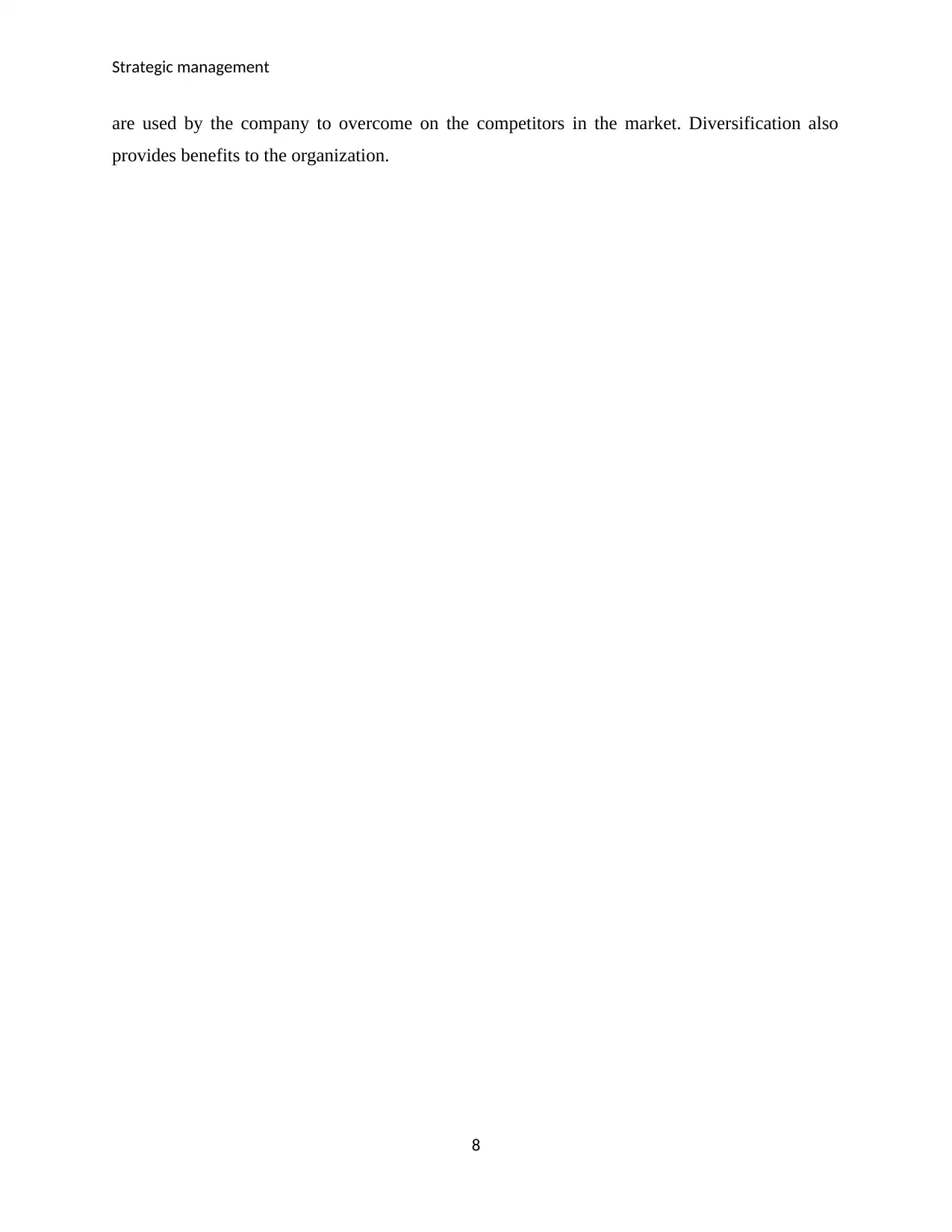
Strategic management
are used by the company to overcome on the competitors in the market. Diversification also
provides benefits to the organization.
8
are used by the company to overcome on the competitors in the market. Diversification also
provides benefits to the organization.
8
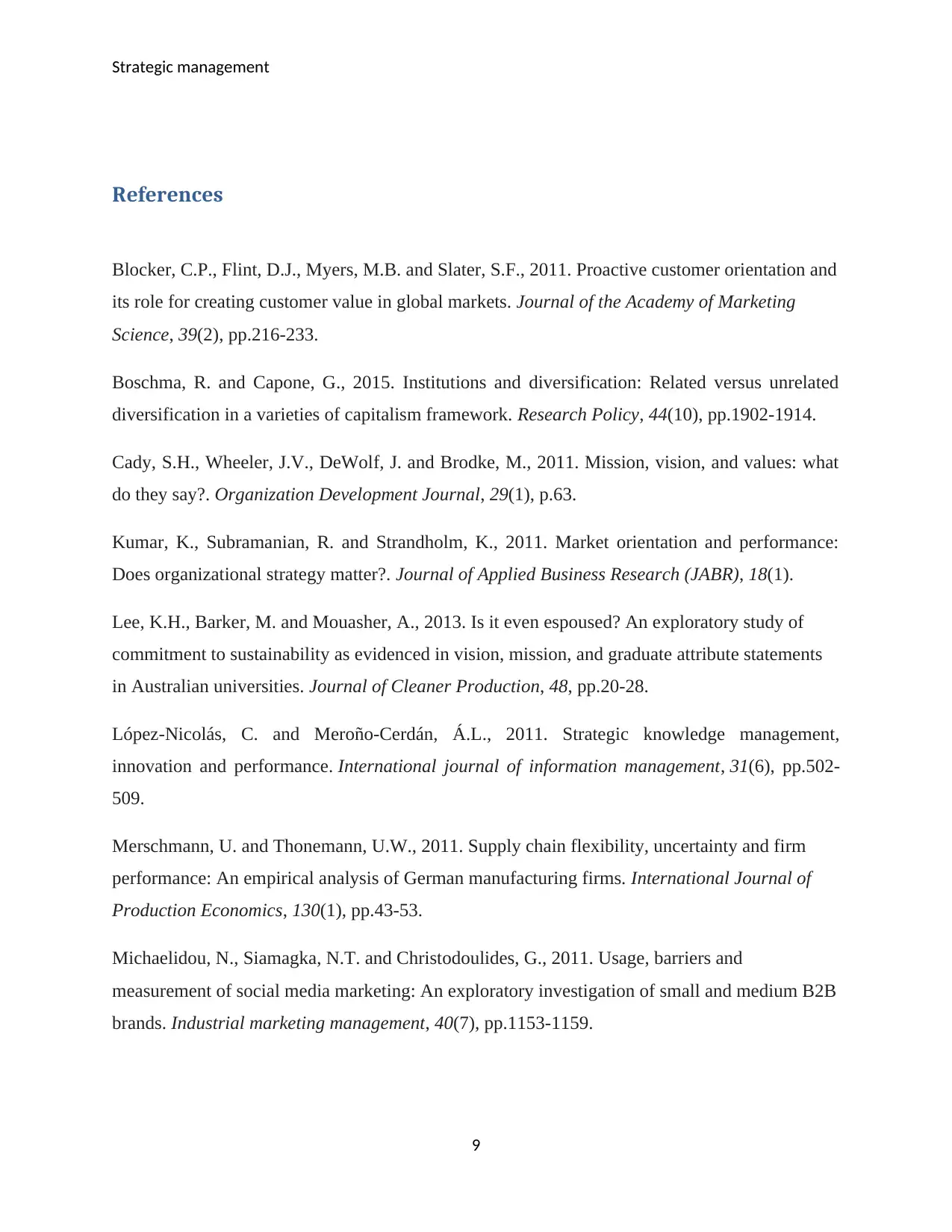
Strategic management
References
Blocker, C.P., Flint, D.J., Myers, M.B. and Slater, S.F., 2011. Proactive customer orientation and
its role for creating customer value in global markets. Journal of the Academy of Marketing
Science, 39(2), pp.216-233.
Boschma, R. and Capone, G., 2015. Institutions and diversification: Related versus unrelated
diversification in a varieties of capitalism framework. Research Policy, 44(10), pp.1902-1914.
Cady, S.H., Wheeler, J.V., DeWolf, J. and Brodke, M., 2011. Mission, vision, and values: what
do they say?. Organization Development Journal, 29(1), p.63.
Kumar, K., Subramanian, R. and Strandholm, K., 2011. Market orientation and performance:
Does organizational strategy matter?. Journal of Applied Business Research (JABR), 18(1).
Lee, K.H., Barker, M. and Mouasher, A., 2013. Is it even espoused? An exploratory study of
commitment to sustainability as evidenced in vision, mission, and graduate attribute statements
in Australian universities. Journal of Cleaner Production, 48, pp.20-28.
López-Nicolás, C. and Meroño-Cerdán, Á.L., 2011. Strategic knowledge management,
innovation and performance. International journal of information management, 31(6), pp.502-
509.
Merschmann, U. and Thonemann, U.W., 2011. Supply chain flexibility, uncertainty and firm
performance: An empirical analysis of German manufacturing firms. International Journal of
Production Economics, 130(1), pp.43-53.
Michaelidou, N., Siamagka, N.T. and Christodoulides, G., 2011. Usage, barriers and
measurement of social media marketing: An exploratory investigation of small and medium B2B
brands. Industrial marketing management, 40(7), pp.1153-1159.
9
References
Blocker, C.P., Flint, D.J., Myers, M.B. and Slater, S.F., 2011. Proactive customer orientation and
its role for creating customer value in global markets. Journal of the Academy of Marketing
Science, 39(2), pp.216-233.
Boschma, R. and Capone, G., 2015. Institutions and diversification: Related versus unrelated
diversification in a varieties of capitalism framework. Research Policy, 44(10), pp.1902-1914.
Cady, S.H., Wheeler, J.V., DeWolf, J. and Brodke, M., 2011. Mission, vision, and values: what
do they say?. Organization Development Journal, 29(1), p.63.
Kumar, K., Subramanian, R. and Strandholm, K., 2011. Market orientation and performance:
Does organizational strategy matter?. Journal of Applied Business Research (JABR), 18(1).
Lee, K.H., Barker, M. and Mouasher, A., 2013. Is it even espoused? An exploratory study of
commitment to sustainability as evidenced in vision, mission, and graduate attribute statements
in Australian universities. Journal of Cleaner Production, 48, pp.20-28.
López-Nicolás, C. and Meroño-Cerdán, Á.L., 2011. Strategic knowledge management,
innovation and performance. International journal of information management, 31(6), pp.502-
509.
Merschmann, U. and Thonemann, U.W., 2011. Supply chain flexibility, uncertainty and firm
performance: An empirical analysis of German manufacturing firms. International Journal of
Production Economics, 130(1), pp.43-53.
Michaelidou, N., Siamagka, N.T. and Christodoulides, G., 2011. Usage, barriers and
measurement of social media marketing: An exploratory investigation of small and medium B2B
brands. Industrial marketing management, 40(7), pp.1153-1159.
9
⊘ This is a preview!⊘
Do you want full access?
Subscribe today to unlock all pages.

Trusted by 1+ million students worldwide
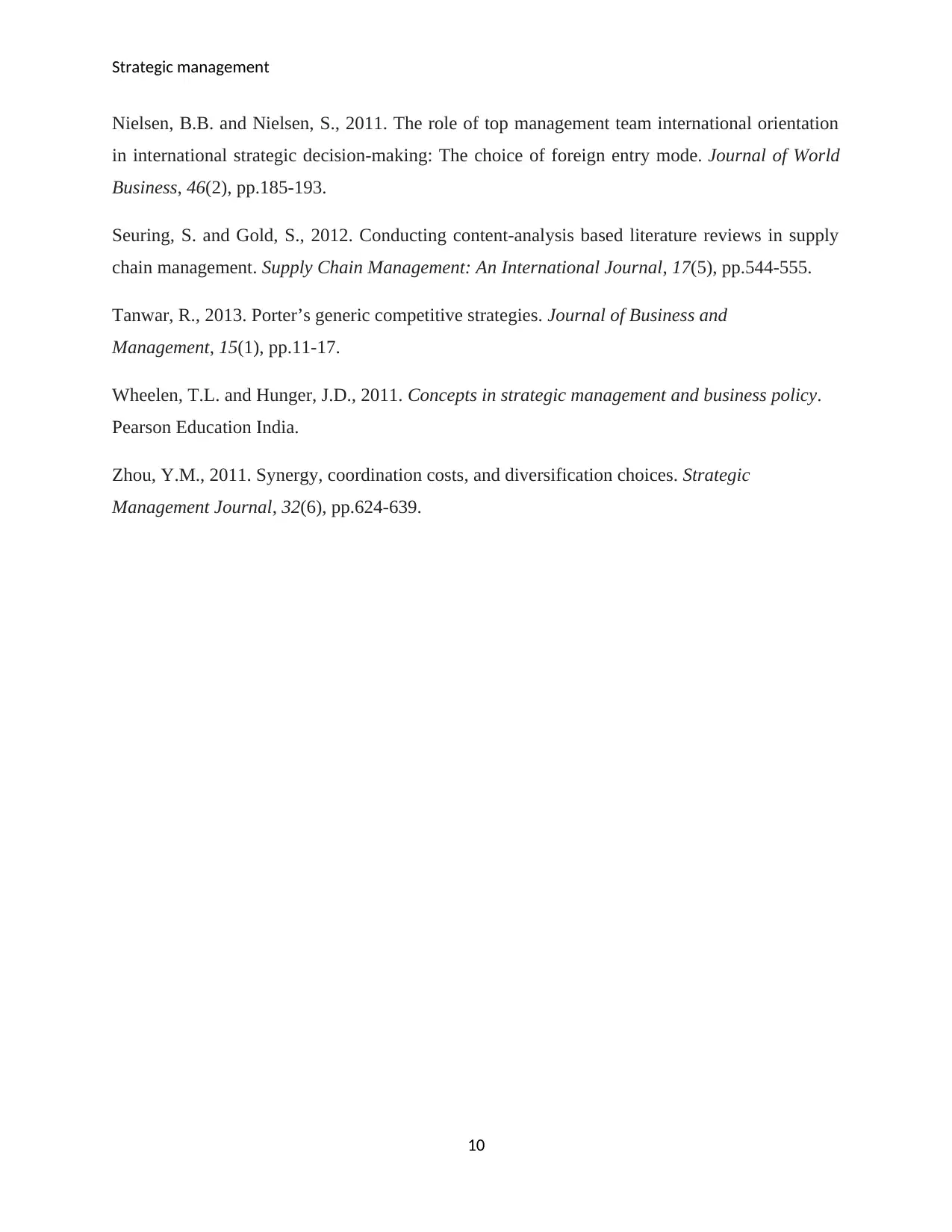
Strategic management
Nielsen, B.B. and Nielsen, S., 2011. The role of top management team international orientation
in international strategic decision-making: The choice of foreign entry mode. Journal of World
Business, 46(2), pp.185-193.
Seuring, S. and Gold, S., 2012. Conducting content-analysis based literature reviews in supply
chain management. Supply Chain Management: An International Journal, 17(5), pp.544-555.
Tanwar, R., 2013. Porter’s generic competitive strategies. Journal of Business and
Management, 15(1), pp.11-17.
Wheelen, T.L. and Hunger, J.D., 2011. Concepts in strategic management and business policy.
Pearson Education India.
Zhou, Y.M., 2011. Synergy, coordination costs, and diversification choices. Strategic
Management Journal, 32(6), pp.624-639.
10
Nielsen, B.B. and Nielsen, S., 2011. The role of top management team international orientation
in international strategic decision-making: The choice of foreign entry mode. Journal of World
Business, 46(2), pp.185-193.
Seuring, S. and Gold, S., 2012. Conducting content-analysis based literature reviews in supply
chain management. Supply Chain Management: An International Journal, 17(5), pp.544-555.
Tanwar, R., 2013. Porter’s generic competitive strategies. Journal of Business and
Management, 15(1), pp.11-17.
Wheelen, T.L. and Hunger, J.D., 2011. Concepts in strategic management and business policy.
Pearson Education India.
Zhou, Y.M., 2011. Synergy, coordination costs, and diversification choices. Strategic
Management Journal, 32(6), pp.624-639.
10
1 out of 10
Related Documents
Your All-in-One AI-Powered Toolkit for Academic Success.
+13062052269
info@desklib.com
Available 24*7 on WhatsApp / Email
![[object Object]](/_next/static/media/star-bottom.7253800d.svg)
Unlock your academic potential
Copyright © 2020–2025 A2Z Services. All Rights Reserved. Developed and managed by ZUCOL.




